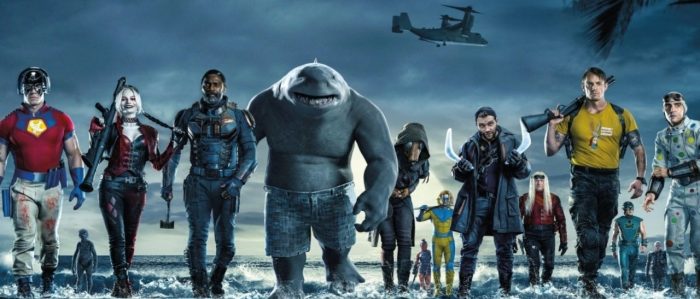
If there was a way to physically walk into James Gunn‘s mind, the folks at the set of The Suicide Squad might have figured it out. Or at least, they put on a good show for me and the group of journalists who had the chance to visit the set of Warner Bros.’ latest DC comic book movie in Atlanta, Georgia in November 2019. But before we got to see the sets of The Suicide Squad, we were ushered into a generic conference room that looked like Gunn’s mind had thrown up all over it (if that analogy doesn’t defy too much logic).
The room was filled from floor-to-ceiling with brightly colored concept art; “vintage” posters of The Suicide Squad characters done in the style of a 1970s exploitation movie; half of a crashed helicopter; and, bizarrely, what looked to be a recreation of some ’70s hole-in-the-wall tropical army bar, complete with a pin-up poster, a ratty red-striped couch, several Suicide Squad-themed arcade games, and of course, a jukebox. Sadly, the bar was not serving any drinks, though a small beat-up table that sat in the corner had on top of it an empty “Conquistador” lager glass, as well as some Spanish cigarettes and some “Black Cat” matches.
It was a remarkable showcase put on for our group (who would be spending several hours in this room, so why not give us a few leftover props and concept art pieces to peruse?) and a sign of Warner Bros.’ enthusiasm to have Gunn on their side, if at least for one movie. It was no accident that the studio managed to snag the Guardians of the Galaxy filmmaker for its sequel to David Ayer’s 2016 film Suicide Squad, which was a critical flop partly because of its haphazard attempt to imitate the things that made Gunn’s Marvel films so successful.
It’s a well-known tale by now, but I’ll briefly recount it: Gunn was fired — and shortly rehired — by Disney as the director of Guardians of the Galaxy Vol. 3, but in the interim, Warner Bros. jumped in and tapped him to direct the Suicide Squad sequel, now known formerly as The Suicide Squad. To everyone, it seemed like Warner Bros. was turning to the man, the visionary himself, to nail what Ayer’s Suicide Squad couldn’t do: give them their own Guardians of the Galaxy. After all, the recipe was already there: a team of criminal misfits given an impossible task, whose missions are heavily scored to popular nostalgic needledrops. Gunn himself was aware of this comparison. But, he told the journalists on the set of The Suicide Squad that day, this isn’t just DC’s version of Guardians of the Galaxy.
“In a lot of ways, when I came to do Guardians and…do a space opera in totally different way, [The Suicide Squad] is my way to do a war film in a completely different way,” Gunn said. “And I thought it was something that I can do to invoke surprise in people by giving them something completely different than what they expect. Like we did with Guardians, the first time people saw that trailer…people might be expecting it to be like Guardians, [or] they might be expecting it to be like the first Suicide Squad, [or] they might be expecting it to be like whatever. But it’s not like any of those things.”
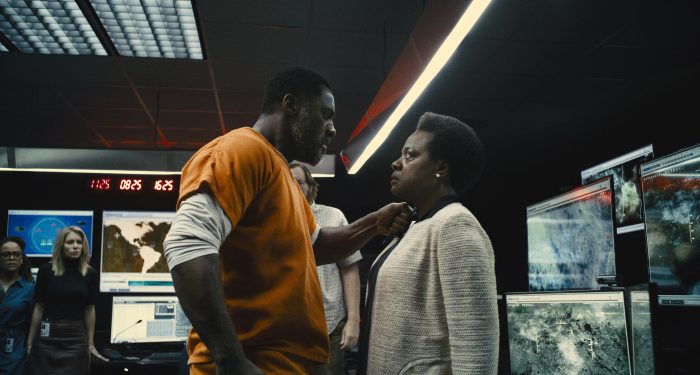
Starting From Scratch (AKA Not a Sequel)
In the aftermath of the release of Ayer’s Suicide Squad, a sequel was quickly greenlit, but slow to get started, as Ayer joined the project, then left, and screenwriters came and went. Then in 2018, fate struck: “All of a sudden, James became available,” Charles Roven, producer of The Suicide Squad who produced Ayer’s Suicide Squad, told me in an interview after the set visit. Before Gunn’s involvement — first as screenwriter, then as director — Roven admitted that things weren’t looking very promising for the Suicide Squad sequel up until that point. “For a certain portion of the period after David Ayer’s Suicide Squad until James became available, we had some development of the project, but none of the development that we had up to that point did we feel was ready to be greenlit,” Roven said, adding:
“[Producer] Peter Safran, who’s also got an obviously strong relationship with Warner Brothers, and Walt Hamada, we all sort of had the same idea at the same time: Let’s see what James is interested in. While we were all talking to him and coming up with ideas, he offered up the fact that if he was going to do a DC comic, he would like it to be The Suicide Squad.”
“Who’s better to bring together a disparate group of outsiders on a mission?” Safran said in an interview on the set of The Suicide Squad. “James Gunn. And that was my pitch to him and his ultimate reaction was, ‘Ask Warner Brothers if I have to be bound by anything that has occurred before, any characters or anything off-base, or can I just start from scratch. And the reaction was, ‘We want Suicide Squad from the mind of James Gunn. That’s what it is. So not a sequel. It’s not a reboot. It’s just James Gunn’s The Suicide Squad.'”
Gunn was unsure of joining the project at first, and had even considered other DC properties, but at the end of the day, it was The Suicide Squad that had his heart.
“At first, I really honestly didn’t think it was going to be Suicide Squad, but I was playing with a few different ideas of a few different DC properties, and this was the one that just took off and I just fell in love with this particular story that we’re telling right now. And I fell in love with some of the characters and the way we can do it and being able to tell a supervillain film like this in a completely different way.”
Gunn was given free rein to craft his vision of The Suicide Squad, emphasis on the “The.” (It may not be cleaner, but it’s cooler.) That’s because while The Suicide Squad is set in the same “universe” as Ayer’s 2016 film, it simply features characters who we might have met in the prior films, as interpreted by Gunn. “The ‘James Gunn universe,’ if you will,” Roven said. And Gunn was given the freedom to “start from scratch,” Safran said. And he did. And that was the way both Gunn and the studio liked it best, Safran said:
“There was no plan before James. There were other writers that had worked on various Suicide Squad scripts over the years, but there was not… This was starting from ground zero, starting from scratch. There was no plan until James said, ‘That’s a movie I want to go make.'”
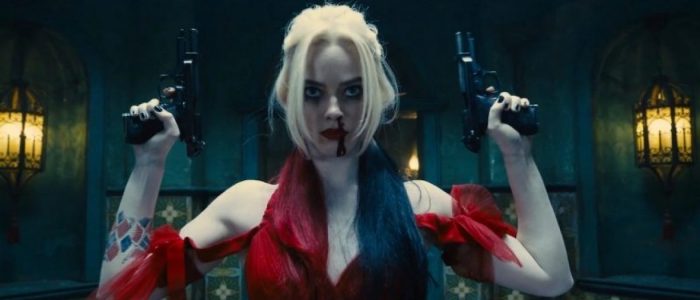
Who Lives? Who Dies?
Meet the squad. There are 14 members, some familiar faces, some not-so-familiar, and some downright terrifying. For the latter, there’s really only one that falls in that category, and that’s Weasel, a man-sized monstrosity that looks like a chemical mutation of an actual weasel that crawled out of a dumpster after getting hit by a bus. But everyone else looks pretty rough too, as per Gunn’s vision of a “grounded, darker,” and ” much, much, much rougher film.”
Of the new “recruits” to the team, there’s Idris Elba as Bloodsport (referred to as “Vigilante” on set to hide his identity), the mercenary with a Deadshot-like backstory who shot Superman with a Kryptonite bullet. Next is John Cena‘s Peacemaker, a ruthless, jingoistic killer described as a “douchey, bro-y Captain America.” David Dastmalchian wears a mournful expression and a silly suit as Polka Dot Man. There’s the mercenary Blackguard, played by Saturday Night Live‘s Pete Davidson. There’s the orange-skinned alien warrior Mongal (Mayling Ng). Flula Borg (who used the word “tasty” a lot while describing his character) plays Javelin, a former Olympic athlete who wields, well, javelins. King Shark, a half-shark, half-man hybrid played in mo-cap by Steve Agee and voiced by Sylvester Stallone. A ratty-looking Ratcatcher II (Daniela Melchior), a bank robber who controls rats, apparently acts as the emotional heart of the film. Michael Rooker reunites with Gunn to play Savant, a vigilante computer hacker with really bad hair. Sean Gunn takes on another mo-cap role to play my mortal enemy, Weasel.
And, “Okay, we made this one up…Arm Fall Off Boy,” Safran said. Who?
“No, no, he’s The Detachable Kid. He’s James’ creation,” Safran clarified with a laugh.
The Detachable Kid, or “TDK” for short (whether that was a riff on The Dark Knight or not, Safran and producer Beth Mickle wouldn’t say), is played by Nathan Fillion.
And, of course, we have our returning members Harley Quinn (Margot Robbie), field leader Rick Flag (Joel Kinnaman), and everyone’s favorite Australian boomerang enthusiast, Captain Boomerang (Jai Courtney). Also returning is Viola Davis as the cold-blooded Task Force X program founder Amanda Waller, while Peter Capaldi also joins as one of the few non-squad villains, The Thinker.
You’re probably thinking…why bother learning any of their names when most of them will probably die before they get a line in? That’s part of the fun of watching a movie like The Suicide Squad. But “James Gunn does not write throwaway characters,” said Dastmalchian, who knows a thing or two about playing a character seen as “disposable” (Polka-Dot Man is one of the most obscure comic book characters out there, and even Gunn describes him as one of the “dumbest” DC supervillains). “If you’re going to know a character’s name in this film, if you’re going to meet a character, that character has somewhere to go. Which again, raises those stakes. Because you don’t know — and in an environment, like the one that our characters are entering — whose head could blow up at any second?”
With popular characters like Harley Quinn (who is probably due her own solo sequel soon), you can probably expect some degree of survival, but even the famous Batman rogue has “been through some things,” a dust and blood-covered Robbie told us in-between takes of a scene we see her shooting with a few other members of the squad, including Bloodsport, King Shark, and Polka-Dot Man. The scene follows the squad as they pick their way through the rubble of a collapsing laboratory in Jotunheim, the political prison in the fictional country of Corto Maltese controlled by tyrannical dictator Silvio Luna. In the scene, the squad members make their way into the collapsed lab through a huge hole in the wall, picking their way through the rubble — Harley, of course, skipping through the dust and rocks in her half-torn red flamenco dress. “She has a mission outfit to start with that’s very different,” Robbie explained. “Yeah, she didn’t come on the mission wearing a ball gown thinking though…although with Harley she could have been like ‘I just like it, this is what I wanted, I wanted to be pretty today.'”
The prospect of Harley Quinn in Gunn’s hands is already pretty exciting – one of the plans the filmmaker has for the character is “Harley Vision,” per concept art, which showed Harley massacring soldiers in a gilded palace with flowers shooting out of her guns. But it’s intriguing to see what Gunn — who turned the once-obscure Guardians of the Galaxy into some of the most popular characters in the MCU — can do with the film’s new characters. Safran said:
“And then all the characters that he selected were just characters that he was a fan of and wanted to play with. I think, in typical fashion for James, he picks more obscure characters. Guardians of Galaxy, they were relatively obscure characters, as well, but he liked the idea of being able to take these characters and imbue them with whatever characters he really wanted, or characteristics that he really wanted to play with.”
One of the standouts was Cena’s Peacemaker, and Safran “didn’t know how great” he was going to be. “He’s just hilarious. There is so much stuff. He’ll go on these riffs that we will never in a million years be able to use, but will be the best DVD extra you’ve ever seen in your life. He’s incredible. But they all are. They’ve all surprised us with… Even guys like Idris, I’ve known his work for so long but there’s an element to him that, until you see him playing this character, I did not expect that,” Safran said.
It’s no surprise Cena is a standout, with the character getting his own HBO Max spin-off series soon (which may or may not be a prequel). But apart from his surprising improv skills, what was the secret sauce that went into Cena’s depiction of the jingoistic “peacekeeper”? According to Cena, it was part “WWE character,” part ” fucking awesome Eddie Van Halen.” It is full circle, of sorts, for the wrestler-turned-actor, who said, “comic book characters are what we try to emulate in WWE.”
But one outrageous character does not a perfect ensemble make, and Cena elaborated on why this team of criminals and supervillains will be so engaging to watch, this time around.
“You have a group of should be superheroes, but you have to remember that all either have been wrongfully accused or done horrible, morally wrong things. So I think the one, they have to lack some sort of complete profile. Superman is just a good dude. You know, you can see the good in people, you can also see the evil in people, but you can see the good. All of these people have real bad personality problems.
So I think when you get that type of group together, that’s what makes it fun. I don’t think anybody is, everybody is kind of different. But I think criminals see criminals, they just size everybody up. And I don’t think that it’s just segregated to my character. I think every one of the people you see behind me is like, how is this person going to stab me in the back? You know, that’s the world they come from.”
Steve Agee added that this motley dynamic is what makes the movie so unique. “These are all characters that for the most part, probably don’t even know the existence of the other ones,” he said. “Some of them do, and it’s the story of The Suicide Squad. They are forced to be together, and do this task, this mission. So, part of the story is just watching these people adapt to being around each other.”
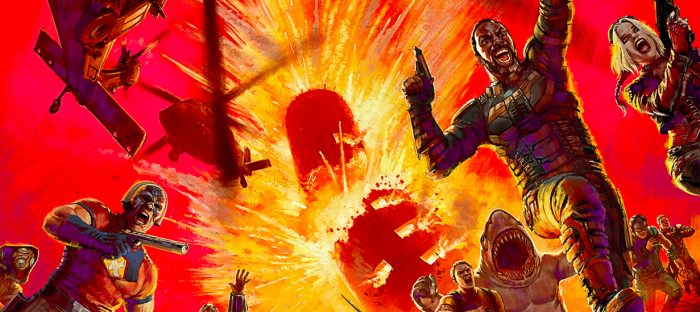
Who/What Inspires the Story?
The Suicide Squad is a war movie, it’s a “noir caper film,” a supervillain take on The Dirty Dozen meets Platoon — those were some of the descriptions thrown around during our visit. And they all sound intriguing, and convincing enough, considering the incredible recreation of a ’70s Vietnam War-inspired battlefield that we toured. But all these influences are superfluous to the one central thing that Gunn drew from for inspiration for his film: the original John Ostrander run of Suicide Squad.
The original Suicide Squad was introduced in 1959’s The Brave and the Bold #25, but the group faded into obscurity before they were revived by Ostrander during DC’s 1986 Legends event, which reimagined Task Force X as a team of incarcerated villains run by government operative Amanda Waller. Combine that ingenious premise with ’80s action movie bombast, and you’ve got the Ostrander Suicide Squad, which Gunn took major inspiration from for The Suicide Squad, which even gives Ostrander a writing credit and a cameo. Gunn said:
“I’m a huge fan of the original John Ostrander run of Suicide Squad which is he created the whole Dirty Dozen-esque supervillains. And I don’t think of it so much as an interpretation of what he wrote but I do think of it as a continuation of what he did. So if the series was simply told, his style today had an R rating, than it would be this movie. So it’s very much in line with that. That’s what he did. He was working with John, who has sort of a little cameo, and so when he was first putting this team together, he was only able to get certain characters, you know. And it really was for him the fun of taking these characters that weren’t as well-known and developing them in a real way. And it’s one of the greatest superhero runs of any comic book series.”
Gunn wanted to pay homage to Ostrander’s run and “keep that sense of [it] being a noir caper film.” Gunn named Dirty Dozen and Kelly’s Heroes as chief examples of the genre that emerged from the late ’60s, which he then takes and remixes.
But in addition to the usual suspects of that kind of specific genre homage, producer Beth Mickle praises Gunn for mixing some magical realism into the film as well, comparing it to films like Beasts of the Southern Wild where the “fantastical” are “treated as these very ordinary things.” Mickle added:
“For me, personally, Where the Wild Things Are, I think it has a lot of that aspect to it. We talked about The Host. We talked about Pearl Hunter. So the magical realism that all those movies have where these extraordinary things were treated very ordinarily, those were all amazing references for it. So when you think about a movie where you’re taking Dirty Dozen meets Beasts of the Southern Wild meets Black Hawk Down… People ask me constantly, what’s this movie going to be like. It’s literally unlike anything you’ve seen before. That’s all I can say when you mix those movies up and turn it into your film, yeah, it’s wildly original.”
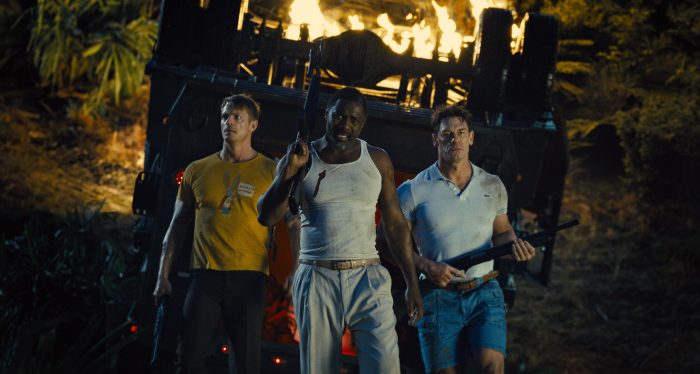
Going to War
When we were finally let out of That Room, we emerged in a jungle. But the world outside hadn’t suddenly transformed into a war-torn tropical battlefield; we had just been led onto one of two sets that we would visit that day: Corto Maltese, the fictional country where a great portion of the bloody, bloody action would be taking place. One set of a guerilla camp has a shack at the center, surrounded by pieces of hacked-up body parts strewn across the ground. A stream runs through the rough, hilly landscape, which I imagine will be filled with blood in post-production.
But it’s not nearly as impressive as the Jotunheim set, the biggest set in the production and one of the biggest sets ever built for a Warner Bros. film. Though this military fortress would probably be more impressive if it hadn’t been blown to smithereens; instead we’re treated to a former Nazi stone fort that is all collapsed spires and rubble, surrounded by downed tanks and a few feet of water — though it does make the (spoilery) fight scene that we get to watch much more exciting. So does Gunn and his team’s commitment to practical effects, both in the sets and in the stunts. Gunn, who rarely uses second-unit directors on his films, hired Mad Max: Fury Road stunt coordinator Guy Norris as second unit director for one scene in the film, who helped craft the kind of “naturalistic, gritty, dirty, rough movie” that Gunn wanted. Mickle said:
“I think, in the vein of trying to get everything in camera, physically, as much as we can, I think it also really lends to the overall style of the movie that James wanted to make which… It’s a very naturalistic film. And, like Peter said, it’s a war film, but it feels like Platoon, and Saving Private Ryan, and Black Hawk Down, where you’re literally in the boat with them arriving on the beach from, Saving Private Ryan, with bullets whizzing past you and running through the sand with bullets hitting the sand and jungle leaves hitting your face as they race through. And that’s where the limitations of CGI worlds really do come into play because you just don’t get that same sort of interaction with sand flying back and hitting people, and them coming up from the water. And I really think you can tell when it’s not physically there. So in James’ mandate to try to make this as naturalistic, gritty, dirty, rough movie that we’re all in the midst of a battle with them, the only way we could really do that with all these sets is to have them standing physically.”
Added Gunn, “Everything is…completely practical, you know, the biggest sets ever on any film. More visual…I was able to take all the heads of departments that I’ve used on other films and kind of just do a Best Of. And Dan Sudick is doing special effects, and he’s doing more special effects or live special effects in this film that all the Marvel movies combined. And so it’s just a much more grounded, darker film.”
That, for Gunn, is where the major difference between The Suicide Squad and Guardians of the Galaxy lies: the practical effects, how big and bombastic everything is. That, and how in The Suicide Squad, “it really is about you don’t know who’s going to get killed.”
“It really is a war [film]. I mean, it is just a more grounded story. It’s a sad story,” Gunn said. “This is a much more complicated story. Some of these characters may end up being good, some of them are definitely not good, and some of them – most of them — are somewhere in between different shades of grey. And that the moral drama, that moral play, the fact that you don’t know anything that’s going to happen is… that unknown of being on edge, that it’s really not knowing what’s going to happen is much different.”
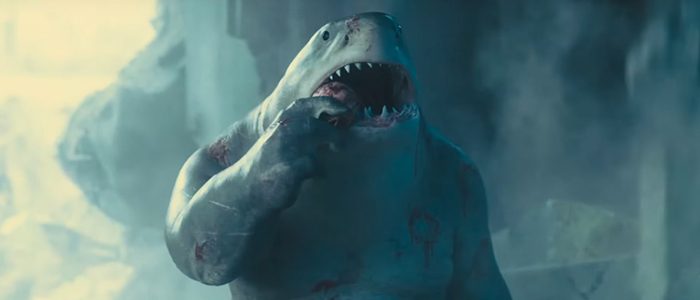
Rated R for “Really, Just Go Nuts”
Did you know The Suicide Squad is rated R? Well, if the red band trailers didn’t clue you in, nor Gunn’s lengthy Twitter Q&A sessions that address what gory shenanigans Warner Bros. let him get away with on a major superhero movie, here’s one final revelation from the cast and crew: expect a lot of blood and cursing.
“James was very specific about the kind of movie that he wanted to make,” Roven said, of the early days in courting Gunn to make a DC movie. ” And quite frankly, when we made the deal with him, he didn’t even want to make the directing portion of the deal. He wanted to make sure that he can execute on his vision.” Roven continued:
“So he pitched us on his vision, and the pitch was pretty specific in many areas. And part of that specificity was, ‘There’s going to be a lot of f-bombs in this thing, there’s going to be a lot of violence. It’s a surreal violence in the sense that it’s almost comic book-y violence, but it’s still going earn you an R-rating. Now I can’t make the movie with my vision without it being R-rated.’ And he said it was going to be in the script, and he delivered.”
F-bombs, disembodied body parts, and lots of “heads blowing up,” Dastmalchian described. “It’s visceral. And it’s James unbound, I think,” he said. “It’s not like he’s making an R rated movie. I think he’s making just the movie that’s in his mind.”
***
The Suicide Squad hits theaters and HBO Max on August 6, 2021.
The post ‘The Suicide Squad’ is James Gunn’s Twist on ‘Dirty Dozen’ for the R-Rated Superhero Era [Set Visit Report] appeared first on /Film.
0 Comments